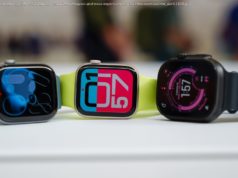The company also boosts its dividend by 16 percent and says it will buy back another $100 billion in stock.
Apple CEO Tim Cook on Tuesday pulled a rabbit out of his hat.
Analysts and investors have worried that the iPhone’s best days are behind it — a problem, since the phone is Apple’s biggest moneymaker — and that the company would report weak results in the June quarter. But iPhone sales didn’t fall off a cliff as feared, and Apple’s projections for sales this quarter were in line with what Wall Street expected. The company also said it’ll return a lot more cash to shareholders, giving its stock as much as a 4 percent boost in after-hours trading.
«We’re thrilled to report our best March quarter ever, with strong revenue growth in iPhone, services and wearables,» Cook said in a statement .
Apple sold 52.2 million iPhones in the three months ended March 31. It was the first full quarter of iPhone X sales, and market watchers have worried about a slowdown for the company’s top-of-the-line device. As a result, analyst estimates for iPhone sales were all over the place. According to a poll by Bloomberg, analysts were predicting that Apple had sold 51.9 million iPhones in the second quarter, while Barrons said analysts overall expected Apple to sell 53 million iPhones. Many analysts had been lowering their estimates as recently as this week.
The average selling price for iPhones rose to $728, but Wall Street expected an average selling price of $742, according to Reuters. A year ago, Apple sold 50.8 million iPhones with an average selling price of $655.
Financial Chief Luca Maestri told Reuters that «clearing channel inventory of 1.8 million iPhones — most of them iPhone X and iPhone 8 models — accounted for some of the difference» in average selling price.
Worries about a big drop in sales in the next quarter didn’t materialize either. For the current quarter, which ends in June, Apple projected revenue of $51.5 billion to $53.5 billion, with the midpoint slightly higher than analysts were expecting. Wall Street expected Apple to report revenue of $52.04 billion in the fiscal third quarter, according to a poll by Yahoo Finance.
«Cook delivers again despite rampant fears,» GBH Insights analyst Daniel Ives noted. He added that Apple’s forecast for the June quarter «was much better than feared» and will be a «major relief» for investors.
Apple, the biggest public company in the world, has been facing worries about slowing iPhones sales growth. Millions of people buy its latest smartphones each quarter, but it’s not the blockbuster demand Apple watchers have seen in the past.
Apple is facing the same problem as other phone vendors: It’s getting harder to woo buyers with the latest and greatest smartphones. Even 2017’s iPhone X, Apple’s first major iPhone redesign in three years, hasn’t gotten consumers excited about phones again. The phone — which starts at $999, $300 more than the 4.7-inch iPhone 8 and $200 more than the 5.5-inch iPhone 8 Plus — is the most expensive iPhone Apple has ever made, and people have been holding onto their «good enough» devices longer than before.
«Apple and the smartphone industry face limited growth prospects,» Barclays analyst Mark Moskowitz noted on Monday as he called the weakening iPhone business «a big problem.»
In February, Apple reported its iPhone unit sales fell about 1 percent, a hit for the holiday quarter. Maestri at the time said that in the March quarter, Apple expected iPhone revenue to rise from the previous year in the double digits on a percentage basis. Cook also noted at the time that Apple had 1.3 billion active installed devices, up 30 percent over two years.
Apple on Tuesday said iPhone revenue climbed 14 percent, to $38 billion.
The iPhone X, released in November, ditched the traditional home button in favor of a new way to unlock the device, called Face ID. It also packed a sharper, bigger screen in a smaller package and gave users the ability to run augmented reality apps. Those changes haven’t been enough to get consumers pumped, though, and worries remain that the mobile market will continue to fall after its first-ever year-over-year decline, in the fourth quarter of 2017.
Over the past two weeks, component suppliers such as Samsung, Broadcom, TSMC and SK Hynix have all warned about lower demand — presumably attributed to Apple — and reports have said the California company has reduced production plans for its priciest iPhone. Many analysts in turn cut their expectations for iPhone sales in the March and June quarters. Some even predict iPhone sales could drop for the full year, a big turnaround from their optimism ahead of the iPhone X launch.
As of market close Monday, Apple shares had fallen 7 percent since April 18, the day before TSMC reported its quarterly results. Shares rebounded 2.3 percent on Tuesday to close at $169.10. They rose 3.8 percent, to $175.45, in after-hours trading.
Cook on Tuesday, likely seeking to alleviate worries about the iPhone X, said the device was the best selling iPhone every week in the March quarter, just as in the December quarter following the device’s launch.
A new tax policy passed in December allows Apple to pay a $38 billion tax bill to bring its overseas cash back to the US. As of the first quarter, which ended in December, Apple had a record $285.1 billion in cash, with most of that held overseas. Investors expected to benefit from that move.
Apple started giving money back to shareholders in August 2012 in the form of dividends and stock buybacks. A year ago, it boosted the amount of money it’s returning to investors through 2019 by $50 billion to $300 billion. Most of that — $210 billion — came from share repurchases. Apple at the time also increased its dividend by 10.5 percent, to 63 cents a share.
On Tuesday, the company said it will finish distributing that $210 billion to shareholders in the fiscal third quarter. It will now give another $100 billion to shareholders — double the amount of its normal yearly buyback boost — and said it will pay a dividend of 73 cents a share, up 16 percent from its prior level.
Apple generates about two-thirds of its revenue from the iPhone, and it’s believed the bulk of its profit also comes from the smartphone. If that market suffers, so do Apple’s financial results.
The company doesn’t have any businesses that come close to the iPhone’s size.






